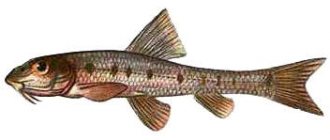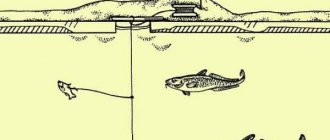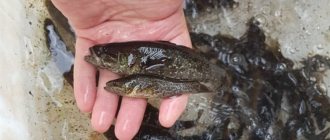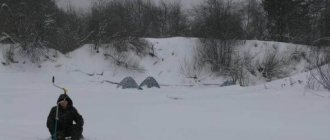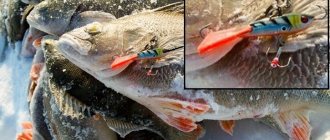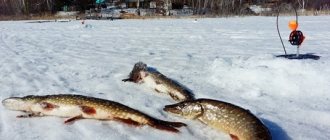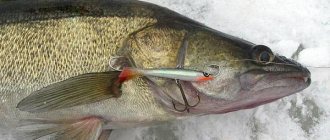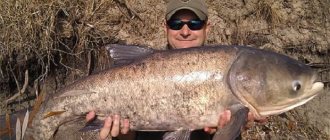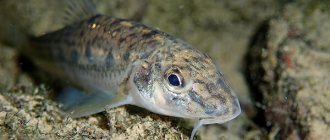Catching gudgeon in winter is not such an easy task when compared with catching gudgeon in the warm season. But if you know where to look for it, and also how and what to catch it with. And they catch gudgeon in winter mainly because it is a very good live bait for catching predatory fish and will be an excellent bait when fishing with gudgeons or any other winter live bait gear. The gudgeon is a universal live bait that is suitable for catching fish such as:
- pike;
- zander;
- burbot;
- ide;
- chub.
Therefore, many fishermen in winter want to get gudgeon as live bait. Some people don’t even know that this fish can be caught in winter.
Tackle and bait for catching gudgeon in winter
To catch gudgeon, the thinnest gear is used, because this fish is not large and the use of coarse equipment will lead to a significant reduction in the number of gudgeon bites or their complete absence. Therefore, to catch gudgeon in winter, it is best to get a separate winter fishing rod, which will be designed specifically for catching small fish such as gudgeon.
To catch gudgeon in winter, you should use a jig weighing approximately 0.2 grams and a fishing line with a cross-section of 0.06-0.07 mm. The use of such gear will make winter gudgeon fishing as productive as possible. It is also very important that the hook of the jig be small and thin. A hook No. 18-20 is best suited. Place bloodworms on the hook of the jig. On a thin and small hook, the bloodworm will hold very well and remain active for a long time and very attractive to the gudgeon.
Although gudgeon can be quite successfully caught in winter using a jig without a bait or other bait, it is still best to catch gudgeon when using bloodworms as bait. And since the gudgeon is a small fish, when catching it with a winter fishing rod, it is necessary to use a sensitive nod. Usually, a gudgeon bite in winter looks like a sharp lowering of the nod down, as if it presses the jig to the bottom. Such bites most often end in a successful hook. So let's sum it up,
what tackle and bait is most suitable for winter gudgeon fishing:
- Mormyshka - 0.2 grams;
- Fishing line - 0.06-0.07 mm;
- Hook - No. 18-20 made of thin wire.
- The nod is the most sensitive;
- The bait is bloodworm.
Fishing technique
You can catch a gudgeon by playing, or simply by using a jig hanging near the bottom, as practice has shown, both methods are effective. When fishing for the game, you should make high-amplitude oscillations near the bottom using a Mylar nod. The bite of the gudgeon is quite sharp and aggressive, the fish immediately tries to go into the aquatic vegetation, so after the bite you should immediately hook it and fish it out on the ice.
Where to catch gudgeon in winter
If you caught gudgeon in open water in summer or spring, then it will not be difficult for you to determine a place that will be promising for catching it in winter. Well, as you know, the gudgeon lives in rivers or artificially created ponds with the help of dams on small rivers. But it is much more difficult to find a gudgeon on a river than in ponds. And the gudgeon from the pond behaves much more actively on the hook when it is used as bait for a predator, constantly trying to go to the bottom.
Typically, the gudgeon prefers places close to the shore and rarely goes to a depth of more than 2-3 meters. In winter, it tries to stay in small depressions with a sandy or silty-sandy bottom. Loves areas where there are various obstacles in the water, in the form of stones, trees, etc. If fishing takes place on a river, then the gudgeon hides behind such barriers from the current, so the bait must be thrown a little downstream from the barrier or directly under it.
In general, a variety of bait attracts gudgeons very well. As bait for gudgeon in winter, you can use either various cereals, or simply throw a small amount of bloodworms into the hole.
A little bit of bait is enough for a minnow. The gudgeon is a small fish, for which a pinch of bloodworm is enough for the entire school to circle around the place where it was caught for half an hour. It is important not to overfeed this small fish, otherwise it will simply get full and the bite will stop.
Places for winter gudgeon fishing
On a body of water familiar from summer fishing, it won’t be difficult to find a promising fishing spot on the ice. Minnows are found in ponds and rivers, but river minnows are more difficult to find. In addition, if you plan to use fish as live bait, then a pond type is better - it is more active on the hook and attracts predatory fish better.
As a rule, the gudgeon is located near the shore, in shallow water, rarely going deeper, two to three meters. In winter, the gudgeon prefers to stand in small holes, bottom depressions with a muddy-sandy or purely sandy bottom. You can easily spot a school of minnows in snags, near rocks and trees fallen into the water. If you are fishing on a river, then it is in such places that bites are most likely: here the gudgeon hides from the current. In this case, the bait should be cast slightly below the obstacle, downstream, or the cast should be made directly under it.
In winter, gudgeon responds well to bait: it can be porridge, or you can throw a little bloodworm into the working hole. You won’t need a lot of complementary feeding, since the gudgeon is a small fish and literally a pinch of bloodworms is enough for complementary feeding. The whole flock of minnows will gather at your hole within half an hour, the main thing is not to feed them so much that they refuse to bite.
How to catch gudgeon in winter. Fishing technique
The technique for catching gudgeon in winter is not complicated and depends on the degree of activity of the gudgeon. Usually, gudgeons are excellently caught all winter in any weather, only occasionally, they stop biting on some days, regardless of the weather.
If the gudgeon bite is active, you can catch it by placing the bait stationary right above the very bottom. If the gudgeon is a little capricious, then you should use active fishing with bait. There are several ways to play minnow this way:
- The bait is played at the very bottom with light and smooth swaying of the nod. The game is played without lifting and creates the illusion of the bloodworm moving with periodic blows to the bottom. Playing sharply with bait will only scare away the gudgeon, so you need to make very light and smooth movements.
- The same smooth and slow game with swinging the bait only with a slow rise of 10-15 cm from the bottom. The rise of the bait should be slow, because the gudgeon will not chase quickly moving prey.
Groundbait and bait
Fishing for gudgeons in winter can be done either with or without bait. The most commonly used and popular bait is the common bloodworm. It should be frozen first and thrown into the hole in small pieces. In this case, the bloodworms will slowly thaw in cold water and gradually disintegrate, spreading the smell and attracting fish.
They also use various purchased or independently prepared vegetable mixtures of fine fractions, but bloodworms are considered a more suitable bait. Simply sprinkle the plant mixture onto the surface of the water in the hole - the swollen small particles will gradually sink to the bottom, luring the fish.
The small gudgeon gets full very quickly, which causes certain difficulties. It is easy to overfeed even with small bloodworms, so many anglers prefer not to use bait at all.
Bloodworms are best suited as bait - the gudgeon prefers it to all other baits. You can catch gudgeon with an empty jig, but with a bait of bloodworms the result will be much better.
The larvae should be planted one at a time, or less often two. To avoid constant replacement of the nozzle with each bite, bloodworm larvae should be baited in a ring.
About gudgeon
The gudgeon is a small fish. Its usual sizes fluctuate around 10-15 cm, the maximum specimens reached a little over 20 cm. The body of the fish is elongated, and there are small antennae on the head. The life expectancy of a gudgeon reaches 10 years. Females are usually larger than males and reach up to 250 g in weight.
In the summer, gudgeons are caught almost everywhere, so in winter you can safely go to any of the reservoirs. But, still, the fish bite better in still water.
The gudgeon usually moves close to the surface of the water and goes to the bottom extremely rarely. It is better to catch it in winter close to the shore, in places where there are a lot of snags and bushes, where it likes to hide. Sometimes the fish burrows into cavities made of clay; this is typical for gudgeon in winter.
Useful tips for increasing your catch:
• To catch minnows in winter, anglers often improve their gear using a rig popularly called a “fool.” In this case, a hook of a suitable size is tied to the end of the main fishing line, and a small lead pellet weighing 0.15-0.30 grams is attached directly to the fishing line 10-12 cm higher. • The gudgeon sticks to the same places throughout the year. If you managed to find summer sites, then in winter you should fish at the same points, marking them with some kind of landmark. • The gudgeon's habitat is very local, so you need to try to drill a hole with maximum accuracy. If there are no bites for a long time, you should move to another place. • The gudgeon is a schooling fish and a fairly large number of fish can be pulled out of a catchable hole. • In large flowing reservoirs with a slow current, the gudgeon that has adapted to such conditions reaches larger sizes than in fast rivers. • When catching minnows for live bait, they should be kept in cold water separately from other species of live bait.
Many may think that there is no point in going fishing for such small fish as gudgeon. But you can not only make fish soup from gudgeon - it is very tasty fried and dried. And catching gudgeon in winter does not require any special gear or professional skills, so many people evaluate such fishing simply as a good pastime. The only difficulty is choosing the right place.
General fishing questions
Where to look for gudgeon in a pond
A uniform distribution of gudgeon is observed in small rivers with active currents, where the bottom is predominantly sandy. Most often, the gudgeon stays at the bottom of shallow water in order to merge with the surface and not be caught by a predator.
In a reservoir, uneven bottoms, the foot of sand dunes, and small dumps act as catching places. In such places, the current twists in different directions, forming eddies of water that bring all kinds of garbage and food.
The mobility of the school is low, but the gudgeon rarely stays in the same places. Today in one place you can catch several dozen scoring minnows, and tomorrow there will not be a single bite in the same territory. The gudgeon is also located next to the dace, the capture of which foreshadows the bite of our fish.
What gear is used to catch gudgeon?
A light float rod with a length of 3 to 6 m is perfect for catching minnows. We choose the thinnest fishing line, as well as a lightweight plastic or feather float with high sensitivity. For the worm we choose a standard size hook No. 6, for bloodworms - No. 4.
When the gudgeon is actively biting, we equip the tackle with two hooks, one of which should be located 4-7 cm higher using a short leash.
Minnows are also caught in winter. Its activity at this time of year is accompanied by the presence of warm sluices and open water in the reservoir. As tackle we use any winter fishing rod, a small hook and bloodworms. We choose the most sensitive nod for a winter fishing rod. The depth for fishing for gudgeon in winter is 1-3 meters on small currents with a sandy bottom.
Advice! When casting, the tackle adjusts the depth so that the hook barely touches the bottom, and in some places even lies.
What time of day is best to fish?
The gudgeon is most active during the day. At this time, in search of food, the gudgeon stays near the illuminated areas of the reservoir in shallow water. At night, the gudgeon sinks to depth and does not show activity.
Baits and lures
In the summer, worms, maggots, caddis flies, bloodworms, jigs, bread crumbs, pearl barley, semolina and other vegetable baits are actively used as bait. In winter, they most often use bloodworms or maggots with a light and small jig, and the gudgeon is not picky about the characteristics of the bait during this period - it can be a single-color or multi-colored jig with bloodworms, maggots, jigs, worms or plant baits.
Fishing in winter
The onset of frost forces the fish to move to the pits, so the activity of the fish decreases slightly. To search for gudgeons in the winter, it is advisable to know in advance places with a sandy bottom. On a small river, the depth of the gudgeon's habitat is average.
To determine the bottom topography, we drill several holes at a distance of 3-5 meters from each other. Steep banks, river bends, and depressions in the area of rifts are the most preferred sites for gudgeon. Most often, the gudgeon stays in the coastal zone, therefore, the middle of the reservoir will not give positive results.
If, after summer fishing, the water area of the coastal zone is well known - the presence of snags, the beach, depths of no more than 2 meters - this will only be an advantage, since it is in these places that the largest accumulation of minnows is observed in the winter.
How to catch with a trap
A liter or two liter plastic bottle (depending on the diameter of the drill) and a string are suitable as a trap.
1. One of the bottles is cut into 2 parts 5-7 cm above the bottom;
2. On the sides of the cut bottom part of the bottle we make small holes with an awl or a needle in the amount of 10 pcs. This is necessary to ensure that the water drains. In the middle of the bottle we make holes with a width of 0.5 cm in quantities of up to 5 pieces;
3. We make a handle using a string or thick fishing line, which we thread through wide holes in the lower cut part. We tie the ends. This is how we will pull out the trap;
4. Cut off the neck from the second part of the cut bottle just below the bend line;
5. Remove the lid from the cut neck;
6. We insert the neck of the bottle with the outer conical side into the lower part of the bottle with a handle;
7. For fixation, use electrical tape, wrapping the edges of the two parts;
8. As bait, we use a piece of bread, which must be placed in the trap, crumble it into pieces with a diameter of 2-3 cm. To ensure that the plastic sinks and does not float up, add a little sand or gravel;
9. We lower the trap to the bottom of the reservoir into a drilled hole where a school of gudgeon is supposedly located.
Be sure to tie a rope or thick fishing line to the handle to pull the feeder. The gudgeon will be caught through the neck of the trap behind the bait, and after a while we pull out the trap.
Jigs for catching minnows in winter
Before choosing a jig, pay attention to the nod test. The most optimal version of nod with dough is 1 g. The most catchy forms of jigs are droplets, pellets, crescents and ants. There is a great variety in the choice of jigs, since the gudgeon is not picky about the type of jig. The main thing is that its weight does not exceed 2 grams.
We use minnows as live bait
The gudgeon is characterized by its widespread use as live bait, both in winter and summer. Any predatory fish can be caught with gudgeon, of which the most common are pike perch, pike, and perch. Such live bait does not tolerate prolonged exposure to warm, slow-flowing water and quickly becomes unusable. You can also catch chub or burbot using gudgeon.
How to hook
There are different ways to bait a minnow as live bait. The classic method of baiting is to hook the minnow on a treble hook about 3 cm below its fin, so as not to damage the ridge - this way the baitfish will stay active longer. The second method is to insert live bait through the gills, which completely eliminates the occurrence of injuries. Unfasten the hook from the leash. We pass the leash through the gills of the minnow so that it comes out completely through the mouth. We fasten the double and pull the leash so that the hook rests on the baitfish’s mouth.
Fishing tactics
In winter, gudgeon fishing often occurs in several holes simultaneously. If fishing takes place on a slope, then 2-3 holes are drilled across the slope and a loaded fishing rod is installed in each - with a good bite, a gudgeon can also bite on a stand. At the same time, it is useful to go around them one by one and play with the tackle.
The gudgeon always stays near the bottom in search of food, so there is no point in raising the bait too high.
Playing with a jig is not difficult and is usually presented in the following variants:
1. The bait sinks to the bottom, followed by a slight rise and descent. After touching the ground, you should move the jig, raising a small cloud of turbidity. 2. Ascents and descents of 10 cm with slight fluctuations and pauses. 3. Very smooth pulling along the bottom with frequent and long stops.
Any game should be leisurely and careful - sudden movements only scare the minnow.
When biting, the nod usually goes down. There are no problems with fishing - the gudgeon is too small a fish to offer any resistance. Just remember that a sharp hook and intensive fishing will easily tear off the gudgeon’s lips and leave the fisherman without prey.
